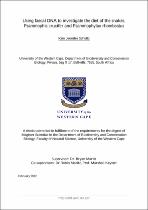| dc.contributor.advisor | Maritz, Bryan | |
| dc.contributor.author | Scholtz, Kim Jennilee | |
| dc.date.accessioned | 2022-05-05T07:17:03Z | |
| dc.date.available | 2022-05-05T07:17:03Z | |
| dc.date.issued | 2022 | |
| dc.identifier.uri | http://hdl.handle.net/11394/9081 | |
| dc.description | >Magister Scientiae - MSc | en_US |
| dc.description.abstract | Knowledge of the feeding ecology of an organism helps us to better understand predator-prey relationships and aspects of species biology, ecology and life-history traits. Understanding the feeding ecologies of snakes is challenging because snakes are generally secretive and often difficult to observe when foraging in the wild. Traditionally, studies attempting to quantify the diets of snakes relied on observing direct predation events, dissecting dead specimens, or microscopy of gut and stomach contents to identify prey species. However, investigations using traditional methods can result in an incomplete understanding of prey utilised by particular snakes. Analysis of prey DNA in snake faeces is a useful method to obtain accurate information on diet. | en_US |
| dc.language.iso | en | en_US |
| dc.publisher | University of the Western Cape | en_US |
| dc.subject | Koeberg Private Nature Reserve | en_US |
| dc.subject | Snake feeding ecology | en_US |
| dc.subject | Cloning | en_US |
| dc.subject | Restriction digestion | en_US |
| dc.subject | DNA sequencing | en_US |
| dc.title | Using faecal DNA to investigate the diet of the snakes, Psammophis crucifer and Psammophylax rhombeatus | en_US |
| dc.rights.holder | University of the Western Cape | en_US |

